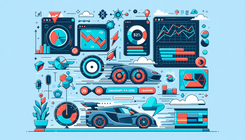Optimize Your Shopify Store's Loading Speed for Better Performance
Understanding the Impact of Site Speed on User Experience
In the highly competitive world of online retail, the speed at which your website loads can significantly impact your business. A slow-loading site can lead to frustrated customers, higher bounce rates, and ultimately, loss of sales. If you're managing a Shopify store and have noticed that your site is sluggish, this guide will help you identify and resolve common issues affecting your site's performance.
Typical Causes of Slow Loading Speeds in Shopify Stores
Unoptimized Images
Images are often the largest assets on a website and can significantly affect load times. While you have already taken steps to reduce image sizes, it is critical to ensure images are properly optimized for different devices. This includes using responsive image techniques and formats such as WebP.
Excessive JavaScript Execution
JavaScript can enhance interactivity but can also slow down your website if not managed properly. Excessive or poorly optimized JavaScript can delay page rendering, especially on mobile devices.
Unused CSS and JavaScript
Unused CSS and JavaScript contribute to page bloat. Streamlining and removing unnecessary code can reduce the load time significantly.
Lazily Loaded Top Banner/Slider
Lazy loading is a great technique to defer loading images that are not immediately visible on the screen. However, applying lazy load to critical content such as the top banner or slider can delay the Largest Contentful Paint (LCP), impacting performance metrics.
Steps to Optimize Your Shopify Store's Performance
1. Optimize Images for Different Devices
- Resize Images for Mobile: Ensure images are appropriately sized for mobile devices. Oversized images can take longer to load on smaller screens.
- Use Responsive Images: Implement responsive image tags to serve different image sizes based on the user's device.
- Switch to Modern Formats: Use WebP, a modern image format that provides superior compression compared to JPG or PNG.
2. Minimize JavaScript Execution Time
- Defer Non-Essential JavaScript: Use the
deferorasyncattributes to load non-essential scripts after the main content has loaded. - Conditional Loading: Load JavaScript only when necessary. For example, load a carousel script only if the carousel is present on the page.
3. Remove Unused CSS and JavaScript
- Audit Your Code: Use tools to identify and remove unused code snippets from your CSS and JavaScript files.
- CSS Purging Tools: Utilize tools like PurgeCSS to automatically remove unused CSS.
4. Avoid Lazy Loading for Critical Content
- Exclude Top Banner/Slider from Lazy Loading: Ensure that critical elements such as the hero image and sliders are not lazily loaded. These elements should load immediately to improve LCP.
5. Properly Size Images
- Define Image Dimensions: Always specify the width and height for images to help browsers allocate space and reduce layout shifts.
6. Defer Offscreen Images
- Implement Lazy Loading for Below-the-Fold Content: Apply lazy loading for images that appear below the initial viewport to save bandwidth and improve load times.
Advanced Shopify Speed Optimization Techniques
Use a Content Delivery Network (CDN)
CDNs distribute your content across multiple servers worldwide, reducing latency and ensuring faster load times for users regardless of their geographical location.
Enable Compression
Enable Gzip or Brotli compression on your servers to reduce the size of your HTML, CSS, and JavaScript files. This can greatly improve load times.
Leverage Browser Caching
Setting up browser caching can help store some of your resources in users' browsers, reducing the need to re-download them on subsequent visits.
Minify CSS and JavaScript
Minifying involves removing unnecessary characters from your code, such as spaces and comments. Minified code still works the same but loads faster due to its reduced size.
Optimize Theme Code
If you're using a theme, consider optimizing its code. Review the theme files for unnecessary scripts, styles, or sections and remove them.
Common Questions and Answers on Shopify Speed Optimization
Q: How can I check my Shopify store's loading speed?
A: Tools like Google PageSpeed Insights or GTmetrix can provide detailed reports on your store's performance and suggest areas for improvement.
Q: Will uninstalling unused apps improve my site's speed?
A: Uninstalling unused apps can help, but sometimes the leftover code can still affect your site's performance. Ensure that you completely remove any code associated with the uninstalled apps.
Q: What are the key performance metrics to monitor?
A: Important metrics include Largest Contentful Paint (LCP), First Input Delay (FID), and Cumulative Layout Shift (CLS). These metrics provide insight into loading performance, interactivity, and visual stability.
Q: How often should I optimize my Shopify store?
A: Regularly. It's good practice to conduct performance audits and optimizations quarterly or whenever you make significant changes to your store.
Conclusion
Optimizing your Shopify store's loading speed is crucial for providing a better user experience, improving conversion rates, and maintaining a competitive edge. By addressing issues like image optimization, JavaScript execution, and unused CSS, you can ensure your store runs smoothly and efficiently. Regular maintenance and staying updated with best practices will help you keep your site fast and reliable.




